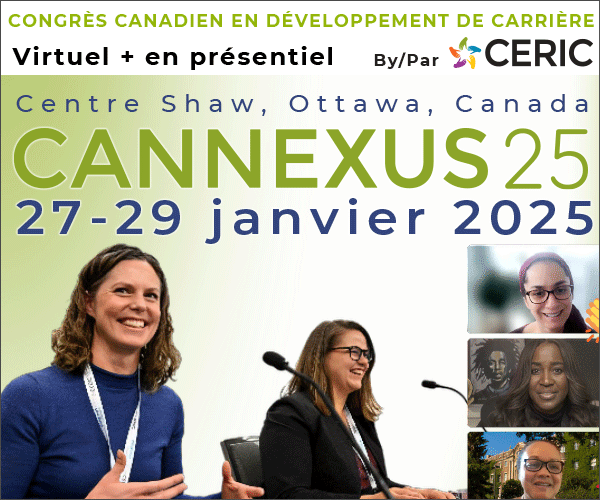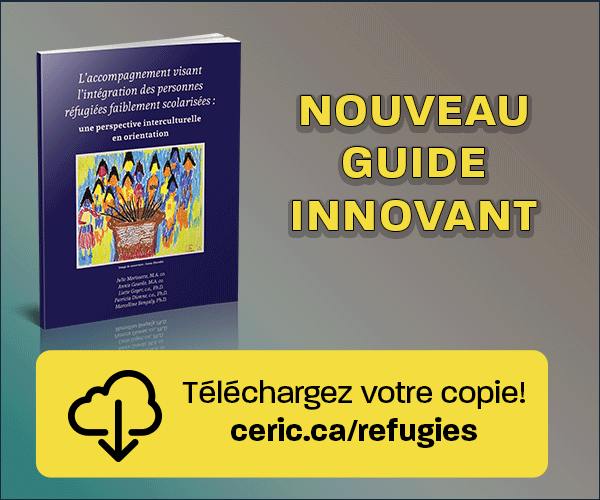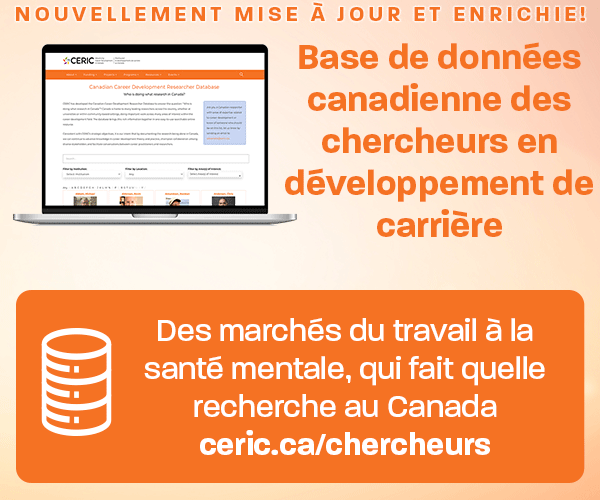Présentation des emplois comme des opportunités de développement des compétences et réponses aux offres d'emploi
DOI :
https://doi.org/10.53379/cjcd.2022.337Mots-clés :
Influence sociale, réflexion écrite, sciences humaines, sciences sociales, expérienceRésumé
De nombreux demandeurs d'emploi inexpérimentés adoptent une stratégie de recherche d'emploi ciblée dans laquelle ils ignorent les offres d'emploi qui semblent sans rapport avec leurs intérêts. Pourtant, bon nombre des emplois qu'ils ignorent au cours de leur recherche d'emploi auraient pu être pertinents pour ces intérêts, car ils offrent des possibilités de développement des compétences. De manière contre-intuitive, une recherche d'emploi exploratoire peut aider ces demandeurs d'emploi à trouver et à occuper des emplois plus pertinents. Dans une expérience (N = 122), nous avons examiné l'effet de l'amorçage d'emplois apparemment non pertinents en tant qu'opportunités de développement de compétences sur les réponses des demandeurs d'emploi inexpérimentés aux offres d'emploi. Par rapport à ceux qui n'ont pas reçu l'amorce, ceux qui ont reçu l'amorce ont rapporté une plus grande pertinence perçue de l'emploi et, à son tour, l'attrait perçu de l'emploi pour les offres d'emploi consultées par la suite. Les résultats suggèrent que les éducateurs professionnels pourraient utiliser l'apprentissage entre pairs, ou la réflexion publique, pour encourager les étudiants à partager leurs idées les uns avec les autres, à recadrer les significations de la pertinence de l'emploi et à rechercher des emplois plus pertinents.
Références
Attard, K. (2012). Public reflection within learning communities: An incessant type of professional development. European Journal of Teacher Education, 35(2), 199-211. https://doi.org/10.1080/02619768.2011.643397
Bargh, J. A. (2016). Awareness of the prime versus awareness of its influence: implications for the real-world scope of unconscious higher mental processes. Current Opinion in Psychology, 12, 49-52. https://doi.org/10.1016/j.copsyc.2016.05.006
Bargh, J. A., Chen, M., & Burrows, L. (1996). Automaticity of social behavior: Direct effects of trait construct and stereotype activation on action. Journal of Personality and Social Psychology, 71(2), 230–244. https://doi.org/10.1037/0022-3514.71.2.230
Chapman, D. S., Uggerslev, K. L., Carroll, S. A., Piasentin, K. A., & Jones, D. A. (2005). Applicant attraction to organizations and job choice: a meta-analytic review of the correlates of recruiting outcomes. Journal of Applied Psychology, 90(5), 928-944. https://psycnet.apa.org/doi/10.1037/0021-9010.90.5.928
Crossley, C. D., & Highhouse, S. (2005). Relation of job search and choice process with subsequent satisfaction. Journal of Economic Psychology, 26, 255-268. https://doi.org/10.1016/j.joep.2004.04.001
Drewery, D., & Pretti, T. J. (2021). The building blocks of relevant work experiences. International Journal of Work-Integrated Learning, 22(2), 241-251. https://www.ijwil.org/files/IJWIL_22_2_241_251.pdf
Drewery, D. Pretti, T. J., & Barclay, S. (2016). Examining the effects of perceived relevance and work-related subjective well-being on individual performance for co-op students. Asia-Pacific Journal of Cooperative Education, 17(2), 119-134. https://files.eric.ed.gov/fulltext/EJ1114001.pdf
Drewery, D. W., Pretti, T. J., & Church, D. (2022). Signaling ‘student-oriented’ job opportunities enhances job attractiveness in work-integrated learning programs. Higher Education Research & Development, 41(2), 346-359. https://doi.org/10.1080/07294360.2020.1857346
Fang, R. T., & Saks, A. M. (2021). Class advantage in the white-collar labor market: An investigation of social class background, job search strategies, and job search success. Journal of Applied Psychology, 106(11), 1695–1713. https://doi.org/10.1037/apl0000842
Gibson, D. E. (2004). Role models in career development: New directions for theory and research. Journal of Vocational Behavior, 65(1), 134-156. https://doi.org/10.1016/S0001-8791(03)00051-4
Hayes, A. F. (2017). Introduction to mediation, moderation, and conditional process analysis: A regression-based approach. Guilford Press.
Hur, H., Maurer, J. A., & Hawley, J. (2019). The role of education, occupational match on job satisfaction in the behavioral and social science workforce. Human Resources Development Quarterly, 30, 407-435. https://doi.org/10.1002/hrdq.21343
Jackson, D., Fleming, J., & Rowe, A. (2019). Enabling the transfer of skills and knowledge across classroom and work contexts. Vocations and Learning, 12, 459-478. https://doi.org/10.1007/s12186-019-09224-1
Jones, D. A., Shultz, J. W., & Chapman, D. S. (2006). Recruiting through job advertisements: The effects of cognitive elaboration on decision making. International Journal of Selection and Assessment, 14(2), 167-179. https://doi.org/10.1111/j.1468-2389.2006.00342.x
Ju, B. and Li, J. (2019). Exploring the impact of training, job tenure, and education-job and skills-job matches on employee turnover intention. European Journal of Training and Development, 43(3/4), 214-231. https://doi.org/10.1108/EJTD-05-2018-0045
Koen, J., Klehe, U. C., Van Vianen, A. E., Zikic, J., & Nauta, A. (2010). Job-search strategies and reemployment quality: The impact of career adaptability. Journal of Vocational Behavior, 77(1), 126-139. https://doi.org/10.1016/j.jvb.2010.02.004
Krumboltz, J. D., & Nichols, C. W. (1990). Integrating the social learning theory of career decision making. In Walsh, W. B., & Osipow, S. H. (Eds.), Career counseling: Contemporary topics in vocational psychology (pp. 159-192). Routledge.
Larkin, J. E., LaPort, K. A., & Pines, H. A. (2007). Job choice and career relevance for today’s college students. Journal of Employment Counseling, 44(2), 86-94. https://doi.org/10.1002/j.2161-1920.2007.tb00027.x
Lent, R. W., Brown, S. D., & Hackett, G. (2000). Contextual supports and barriers to career choice: A social cognitive analysis. Journal of Counseling Psychology, 47(1), 36-49. https://doi.org/10.1037/0022-0167.47.1.36
Lievens, F., & Highhouse, S. (2003). The relation of instrumental and symbolic attributes to a company’s attractiveness as an employer. Personnel Psychology, 56(1), 75-102. https://doi.org/10.1111/j.1744-6570.2003.tb00144.x
Moore, K., & Khan, M. H. (2020). Signalling organizational commitment to employability through job advertisements: the communication of HRD practices to young inexperienced job seekers. Human Resource Development International, 23(1), 25-45. https://doi.org/10.1080/13678868.2019.1679569
Muldoon, O. T., & Kremer, J. M. D. (1995). Career aspirations, job satisfaction and gender identity in female student nurses. Journal of Advanced Nursing, 21, 544-550. https://doi.org/10.1111/j.1365-2648.1995.tb02739.x
Nevison, C., Drewery, D., Pretti, J., & Cormier, L. (2017). Using learning environments to create meaningful work for co-op students. Higher Education Research & Development, 36(4), 807-822. https://doi.org/10.1080/07294360.2016.1229268
O’Reilly, C. A., Chatman, J. A., & Caldwell, M. M. (1991). People and organizational culture: A Q-sort approach to assessing person-organization fit. Academy of Management Journal, 34, 487–516. https://doi.org/10.5465/256404
Okay-Somerville, B., & Scholarios, D. (2022). Focused for some, exploratory for others: Job search strategies and successful university-to-work transitions in the context of labor market ambiguity. Journal of Career Development, 49(1), 126-143. https://doi.org/10.1177%2F08948453211016058
Parker, P., Hall, D. T., & Kram, K. E. (2008). Peer coaching: A relational process for accelerating career learning. Academy of Management Learning & Education, 7(4), 487-503. https://doi.org/10.5465/amle.2008.35882189
Petry, T., Treisch, C., & Peters, M. (2021). Designing job ads to stimulate the decision to apply: a discrete choice experiment with business students. The International Journal of Human Resource Management, 1-37. https://doi.org/10.1080/09585192.2021.1891112
Redpath, L. (1993). Education-job mismatch among Canadian university graduates: Implications for employers and educators. Canadian Journal of Higher Education, 24(2), 90-114. https://doi.org/10.47678/cjhe.v24i2.188441
Royal Bank of Canada (2018). Humans wanted: How Canadian youth can thrive in the age of disruption. https://www.rbc.com/dms/enterprise/futurelaunch/_assets-custom/pdf/RBC-Future-Skills-Report-FINAL-Singles.pdf
Steed, S. (2018, January 25). Too many graduates are mismatched to their jobs. What’s going wrong? The Guardian. https://www.theguardian.com/higher-education-network/2018/jan/25/too-many-graduates-are-mismatched-to-their-jobs-whats-going-wrong
Van Hoye, G., & Lievens, F. (2007). Social influences on organizational attractiveness: Investigating if and when word of mouth matters. Journal of Applied Social Psychology, 37(9), 2024-2047. https://doi.org/10.1111/j.1559-1816.2007.00249.x
Van Hoye, G., & Lievens, F. (2009). Tapping the grapevine: A closer look at word-of-mouth as a recruitment source. Journal of Applied Psychology, 94(2), 341-352. https://doi.org/10.1037/a0014066
Walker, H. J., Feild, H. S., Giles, W. F., Bernerth, J. B., & Short, J. C. (2011). So what do you think of the organization? A contextual priming explanation for recruitment web site characteristics as antecedents of job seekers’ organizational image perceptions. Organizational Behavior and Human Decision Processes, 114(2), 165-178. https://doi.org/10.1016/j.obhdp.2010.11.004
Wanberg, C. R., Ali, A. A., & Csillag, B. (2020). Job seeking: The process and experience of looking for a job. Annual Review of Organizational Psychology and Organizational Behavior, 7, 315-337. https://doi.org/10.1146/annurev-orgpsych-012119-044939
Zhao, X., Lynch Jr, J. G., & Chen, Q. (2010). Reconsidering Baron and Kenny: Myths and truths about mediation analysis. Journal of Consumer Research, 37(2), 197-206. https://doi.org/10.1086/651257

Téléchargements
Publié-e
Comment citer
Numéro
Rubrique
Licence
(c) Tous droits réservés La Revue canadienne de développement de carrière 2022

Cette œuvre est sous licence Creative Commons Attribution - Pas d'Utilisation Commerciale - Pas de Modification 4.0 International.











